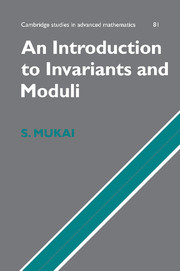Book contents
- Frontmatter
- Contents
- Preface
- Acknowledgements
- Introduction
- 1 Invariants and moduli
- 2 Rings and polynomials
- 3 Algebraic varieties
- 4 Algebraic groups and rings of invariants
- 5 The construction of quotient varieties
- 6 The projective quotient
- 7 The numerical criterion and some applications
- 8 Grassmannians and vector bundles
- 9 Curves and their Jacobians
- 10 Stable vector bundles on curves
- 11 Moduli functors
- 12 Intersection numbers and the Verlinde formula
- Bibliography
- Index
- References
8 - Grassmannians and vector bundles
Published online by Cambridge University Press: 05 February 2015
- Frontmatter
- Contents
- Preface
- Acknowledgements
- Introduction
- 1 Invariants and moduli
- 2 Rings and polynomials
- 3 Algebraic varieties
- 4 Algebraic groups and rings of invariants
- 5 The construction of quotient varieties
- 6 The projective quotient
- 7 The numerical criterion and some applications
- 8 Grassmannians and vector bundles
- 9 Curves and their Jacobians
- 10 Stable vector bundles on curves
- 11 Moduli functors
- 12 Intersection numbers and the Verlinde formula
- Bibliography
- Index
- References
Summary
It is well known that the set of vector subspaces of a fixed dimension in a fixed vector space is a projective algebraic variety, called the Grassmannian. We are going to examine the Grassmannian as an example of a Proj quotient by a group action of ray type. In Section 8.1, using a construction of this variety by means of invariants, we shall study, in the case G(2, n), its coordinate ring. We compute its Hilbert series, its generators and their relations.
From Section 8.2 we shall review, as preparation for the chapters which follow, the theory of modules over a ring. We discuss localisation and gluings by partitions of unity, free modules, tensor products and flat modules. In Section 8.3 we define locally free modules and invertible modules, and the properties of these which follow from flatness.
The set of equivalence classes of invertible modules forms an abelian group under the tensor product, called the Picard group of the ring. For the ring of integers of an algebraic number field, for example, this coincides with the divisor class group. In Section 8.4 we calculate the Picard group explicitly in the cases of an imaginary quadratic field and of an affine hyperelliptic curve (that is, a quadratic extension of the polynomial ring k[x]). This paves the way for the later discussion of the Jacobian variety.
Just as one obtains an algebraic variety by gluing together affine spectra of algebras, so too one can glue invertible modules, or locally free modules, over a ring to form line bundles, or vector bundles, over algebraic varieties. The line bundles (vector bundles of rank 1) form a group Pic X under ⊗, which coincides with Pic R when X = Spm R is affine.
In the final section we construct the tautological line bundle on a projective space and the universal vector bundle on a Grassmannian G(r, n), and use this to show that the Grassmannian represents the functor Gr(r, n) which assigns to a ring R the set of locally free rank r submodules of R⊕n up to isomorphism.
- Type
- Chapter
- Information
- An Introduction to Invariants and Moduli , pp. 234 - 286Publisher: Cambridge University PressPrint publication year: 2003

